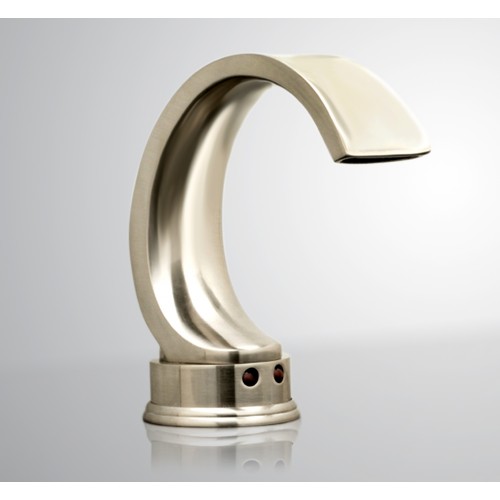We’re a culture accustomed to the idea of hands-free faucets in public places. In the restrooms of airports, restaurants and malls, we know the routine: We place our hands under the faucet, waiting for the water to flow out of the spigot.
So it’s easy to imagine no-touch faucets in the bathroom and kitchen, given how more manufacturers have been adapting the hands-free technology for commercial-grade faucets to the home.
“It’s an accepted technology now, from a time saving standpoint and water-saving standpoint and to prevent spreading germs,” says Janice Disney, senior merchant for faucets at The Home Depot.

It’s an advantage to be able to handle and wash raw food in the kitchen sink without having to touch the lever.
There are no faucet handles to touch, so there’s less water getting dripped on the counter of a powder room sink. An automated faucet also can make it much easier for some people with disabilities, especially those who have difficulty turning a handle, to wash their hands.
There are two main categories of technology used to make a faucet touchless. One uses an infrared sensor that projects an invisible beam of light. When you put your hand in front of that beam, your hand reflects the light back to the sensor, which then signals to the faucet to release the flow of water.
The other is capacitive technology, which turns the spout into a proximity sensor that activates the faucet when your hand is a few inches from the spout.
But before you go hands-free, it’s important to consider the following:
Type of sink. Touchless faucets usually need only one hole. Most kitchen sinks are equipped with one hole, while bathroom sinks typically have three holes. So replacing your faucet with a hands-free model may mean having to replace your sink, too, unless you choose a model that comes with a plate that covers the other holes.
Power source. Some faucets run on short- or long-term batteries, or are AC-powered. Others include the option to have access to both power sources, as well as switch to manual operation. More manufacturers are moving toward providing several options, Disney says.
Auto shut-off feature. After several seconds to a couple of minutes, some faucets automatically turn themselves off, preventing water from running endlessly.
WaterSense specification. This feature means that a faucet’s maximum flow rate is set at 1.5 gallons per minute, tested at a flowing pressure of 60 pounds per square inch, which is the common water pressure in most households. This flow rate is less than that of traditional faucets and therefore saves water.
Temperature setting. Find out how easily the temperature can be adjusted. Some faucets are equipped with a handle that allows you to change the temperature. For other faucets, you have to adjust the temperature beneath the sink.
Price. Touchless faucets tend to cost more than traditional faucets. Models from major brands range in price from $250 to about $600, and usually include a warranty. These are sold at kitchen and bath specialty showrooms, hardware stores and home-improvement centers. There are lesser-known brands that are available for less than $100 online.
Lisa Liddane


Convenience of a hands-free faucet available at home, too